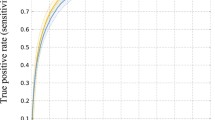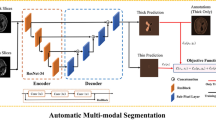Abstract
Accurate segmentation of ventricular cerebrospinal fluid (CSF) regions in stroke CT images is important in assessing stroke patients. Manual segmentation is subjective, time consuming and error prone. There are currently no methods dedicated to extracting ventricular CSF regions in stroke CT images. 102 ischemic stroke CT scans (slice thickness between 3 and 6 mm, voxel size in the axial plane between 0.390 and 0.498 mm) were acquired. An automated template-based algorithm is proposed to extract ventricular CSF regions which accounts for the presence of ischemic infarct regions, image noise, and variations in orientation. First, template VT2 is registered to the scan using landmark-based piecewise linear scaling and then template VT1 is used to further refine the registration by partial segmentation of the fourth ventricle. A region of interest (ROI) is found using the registered VT2. Automated thresholding is then applied to the ROI and the artifacts are removed in the final phase. Sensitivity, dice similarity coefficient, volume error, conformity and sensibility of segmentation results were 0.74 ± 0.12, 0.8 ± 0.09, 0.16 ± 0.11, 0.45 ± 0.39, 0.88 ± 0.09, respectively. The processing time for a 512 × 512 × 30 CT scan takes less than 30 s on a 2.49 GHz dual core processor PC with 4 GB RAM. Experiments with clinical stroke CT scans showed that the proposed algorithm can generate acceptable results in the presence of noise, size variations and orientation differences of ventricular systems and in the presence of ischemic infarcts.










Similar content being viewed by others
References
Chang, H. H., Zhuang, A. H., Valentino, D. J., & Chu, W. C. (2009). Performance measure characterization for evaluating neuroimage segmentation algorithms. NeuroImages, 47(1), 122–135.
Chen, W., Najarian, K. (2009). Segmentation of ventricles in brain CT images using Gaussian mixture model method. IEEE/ICME International Conference on Complex Medical Engineering (ICME2009) pp. 15–20.
Chen, W., Smith, R., Ji, S., Ward, K., Najarian, K. (2009). Automated ventricular systems segmentation in brain CT images by combining low-level segmentation and high-level template matching. BMC Medical Informatics and Decision Making, 9(Suppl 1).
Gupta, V., Ambrosius, W., Qian, G., Blazejewska, A., Kazmierski, R., Urbanik, A., & Nowinski, W. L. (2010). Automatic segmentation of cerebrospinal fluid, white and gray matter in unenhanced computed tomography images. Academic Radiology, 17(11), 1350–1358.
Holden, M., Schnable, J. A., & Hill, D. L. G. (2010). Quantifying small changes in brain ventricular volume using non-rigid registration. LNCS, 2208, 49–56.
Liu, J., Huang, S., & Nowinski, W. L. (2009). Automatic segmentation of the human brain ventricles from MR images by knowledge-based region growing and trimming. Neuroinformatics, 7(2), 131–146.
Liu, J., Huang, S., Volkau, I., Ambrosius, W., Lee, L. C., & Nowinski, W. L. (2010). Automatic model-guided segmentation of the human brain ventricular system from CT images. Academic Radiology, 17(6), 718–726.
Lövblad, K. O., & Baird, A. E. (2010). Computed tomography in acute ischemic stroke. Neuroradiology, 52, 118–175.
Nowinski, W. L. (2001). Modified Talairach landmarks. Acta Neurochirurgica, 143(10), 1045–1057.
Nowinski, W. L., Qian, G., Bhanu Prakash, K. N., Hu, Q., & Aziz, A. (2006). Fast Talairach transformation for magnetic resonance neuroimages. Journal of Computer Assisted Tomography, 30(4), 629–641.
Nowinski, W. L., Chua, B. C., Qian, G. Y., Marchenko, Y., Puspitasari, F., Nowinska, N. G., & Knopp, M. V. (2011). The human brain in 1492 pieces: Structure, vasculature, and tracts. New York: Thieme.
Otsu, N. (1979). A threshold selection method from gray-level histogram. IEEE Transactions on System Man and Cybemetic, 9(1), 62–66.
Puspitasari, F., Volkau, I., Ambrosius, W., & Nowinski, W. L. (2009). Robust calculation of the midsagittal plane in CT scans using the Kullback-Leibler’s measure. International Journal of Computer Assisted Radiology and Surgery, 4(6), 535–547.
Rao, S. R., Rao, T. R., Ovchinnikov, N., McRae, A., & Rao, A. V. C. (2007). Unusual isolated ossification of falx cerebri: A case report. Neuroanatomy, 6, 54–55.
Schnack, H. G., Hulshoff, P. H. E., Baare, W. F. C., Viergever, M. A., & Kahn, R. S. (2001). Automatic segmentation of the ventricular system from MR images of the human brain. NeuroImage, 14, 95–104.
Volkau, I., Puspitasari, F., Ng, T. T., Bhanu Prakash, K. N., Gupta, V., Nowinski, W. L. (submitted) Simple and fast registration of multi-modal and time-series sparse neuroimages using statistical localization of landmarks. Neuroradiology Journal.
Xia, Y., Hu, Q., Aziz, A., & Nowinski, W. L. (2004). A knowledge-driven algorithm for a rapid and automatic extraction of the human cerebral ventricular system from MR neuroimages. NeuroImage, 21(1), 269–282.
Zou, K. H., Warfield, S. K., Bharatha, A., et al. (2004). Statistical validation of image segmentation quality based on spatial overlap index. Academic Radiology, 11, 178–189.
Author information
Authors and Affiliations
Corresponding author
Appendices
Appendix A. Partial Segmentation of Fourth Ventricle (V4)
First a 3D ROI that includes all of V4 is defined. (Xia et al. 2004) defines a (45 × 55 mm2) 2D ROI on the MSP taking into account of variations and irregularities of size and dimensions of V4. Through variability studies, we extend it to a 3D ROI (12 × 45 × 55 mm3). This ROI is mapped to the image to form a 3D crop box (Fig. 11b).
More slices than necessary to segment V4 are usually included in the 3D crop box. It is crucial to choose just the few slices where V4 lies to reduce errors in the later steps of segmentation. We first segment the parenchyma by a series of thresholding, morphological erosion and dilation operations followed by choosing the largest connected component. Let Ni be the number of voxels of parenchyma for slice i. Let ANi be the number of accumulated voxels for slice i, i.e.,
Let APi be the accumulated percentage of parenchyma, i.e.,
- APi :
-
ANi/total number of voxels of parenchyma in all slices
Experiments show that the slices that contain significant portion of V4 lies within the range of APi [0.06, 0.2]. Automatic thresholding (Otsu 1979) is applied to the crop regions in these slices. Artifacts included in above process are removed by removing regions that are away from the MSP and the largest connected component is chosen, (see Fig. 11c).
Appendix B. Fast Talairach Transformation (FTT)
The FTT (Nowinski et al. 2006) is a rapid version of the Talairach transformation (TT) with the modified Talairach landmarks (Nowinski 2001). The modified Talairach landmarks are introduced to overcome several problems associated with the original Talairach landmarks. Two intercommissural lines are introduced: central intercommissural line and tangential intercommissural line. The central intercommissural line is passing through the centres of the anterior commissure and the posterior commissure on the midsagittal (interhemispheric) plane. The tangential intercommissural line is tangential dorso-posteriorly to the anterior commissure and ventroanteriorily to the posterior commissure on the midsagittal plane. The modified landmarks are defined as follows, see Fig. 12.
-
AC: The anterior commissure is a point within the intersection of the anterior commissure with the midsagittal (interhemispheric) plane. Three definitions of the AC landmark are introduced: central, where the AC landmark is the central point (the gravity center) of the anterior commissure internal, where the AC landmark is the intersection of the central intercommissural line and the line passing through the posterior edge of the anterior commissure tangential, where the AC landmark is the tangent point of the tangential intercommissural line with the anterior commissure.
-
PC: The posterior commissure is a point within the intersection of the posterior commissure with the midsagittal plane. Three definitions of the PC landmark are introduced: central, where the PC landmark is the central point (the gravity center) of the posterior commissure internal, where the PC landmark is the intersection of the central intercommissural line and the line passing through the anterior edge of the posterior commissure tangential, where the PC landmark is the tangent point of the tangential intercommissural line with the posterior commissure.
-
L: The point of intersection of three planes: the intercommissural (AC-PC axial) plane, the coronal plane passing through the PC, and the sagittal plane passing through the most lateral point of the parietotemporal cortex for the left hemisphere.
-
R: The point of intersection of three planes: the intercommissural plane, the coronal plane passing through the PC, and the sagittal plane passing through the most lateral point of the parietotemporal cortex for the right hemisphere.
-
A: The point of intersection of three planes: the intercommissural plane, the midsagittal plane, and the coronal plane passing through the most anterior point of the frontal cortex.
-
P: The point of intersection of three planes: the intercommissural plane, the midsagittal plane, and the coronal plane passing through the most posterior point of the occipital cortex.
-
S: The point of intersection of three planes: the coronal plane passing through the PC, the midsagittal plane, and the axial plane passing through the highest, most superior (most dorsal) point of the parietal cortex.
-
I: The point of intersection of three planes: the coronal plane passing through the AC, the midsagittal plane, and the axial plane passing through the lowest, most inferior (most ventral) point of the temporal cortex.
The identification of the landmarks is fully automatic and is done in 3 steps: (1) calculation of the MSP, (2) computing of the AC and PC landmarks, and (3) calculation of the cortical landmarks. Having the MSP and landmarks calculated, a processed data set is reformatted in the AC-PC plane and the atlas is scaled piecewise linearly and superimposed on this data set. The calculations are performed in the Talairach coordinate system with its origin at the AC landmark, x axis oriented from the right to left hemisphere, y axis oriented postero-anteriorly, and z axis oriented dorso-ventrally.
Rights and permissions
About this article
Cite this article
Poh, L.E., Gupta, V., Johnson, A. et al. Automatic Segmentation of Ventricular Cerebrospinal Fluid from Ischemic Stroke CT Images. Neuroinform 10, 159–172 (2012). https://doi.org/10.1007/s12021-011-9135-9
Published:
Issue Date:
DOI: https://doi.org/10.1007/s12021-011-9135-9






